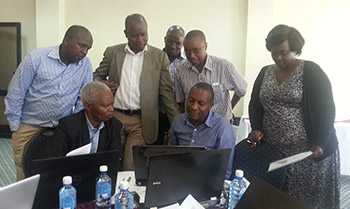System Strengthening – A One Health Approach

Today’s global society links communities both physically and economically. It also increases the risk of major economic losses and numerous deaths from zoonotic diseases that spread between animals and people, like rabies, avian influenza, and Rift Valley fever. One way to prevent such devastation and protect the public is with One Health—a collaborative approach that connects health professionals across human, animal, and environmental health sectors at the local, national, regional, and global levels.
CDC’s One Health Office (OHO) provides countries with the technical assistance necessary to adopt this approach.
Prioritizing Zoonotic Disease
In 2013, CDC’s OHO, with the aid of the Global Disease Detection (GDD) Kenya Center and in-country partners, developed the One Health Zoonotic Disease Prioritization (OHZDP) tool – conducting a small-scale pilot with country staff. After refining the tool, the CDC OHO and the GDD Thailand Center carried out a larger pilot in 2014.
CDC’s OHO leads the OHZDP workshops that bring together multiple health sectors to develop a priority list of zoonotic diseases. The Global Health Security Agenda (GHSA)–a framework for countries to reach the International Health Regulation goals to prevent, detect, and respond to disease threats effectively–identifies zoonotic diseases as a priority target area and encourages countries to use this tool to focus their One Health efforts.
Developing a list of priority zoonotic diseases helps public health sectors strategically use financial and human resources to:
- Strengthen and expand laboratory capacity,
- Develop/enhance disease surveillance programs in human and animal populations,
- Develop multi-sectoral outbreak response plans, and
- Create joint prevention and control strategies for human and animal health.
The Kenya Experience
In September 2015, the Kenya Zoonotic Disease Unit, a collaboration between various Kenyan ministries, CDC’s GDD Kenya Center, and the Department of Defense’s Defense Threat Reduction Agency, conducted an OHZDP workshop to determine its priority zoonotic diseases. CDC’s headquarters staff provided technical support and GDD Kenya’s One Health staff led the effort for Kenyan public health professionals, scientists, researchers, and partners to set the priority for 36 endemic and emerging zoonotic diseases.

Participants ranked diseases based on severity of illness in humans, epidemic potential, and socioeconomic impact on livestock, disease prevalence in humans and livestock, and possible availability of effective intervention. Kenya determined its top five disease threats as: 1) anthrax, 2) human African trypanosomiasis, 3) rabies, 4) brucellosis, and 5) Rift Valley fever. This interdisciplinary approach required that all health sectors participate and identify common priorities to better lead management of zoonotic diseases. For more information on this collaborative work, please visit: https://www.ncbi.nlm.nih.gov/pubmed/27557120.
CDC has held additional workshops in Ethiopia, South Africa, Democratic Republic of Congo, Cameroon, and Azerbaijan, and will continue working with countries to implement a One Health approach. The collaboration of all health sectors strengthens systems to better protect the world from zoonotic disease threats in people and animals and to meet GHSA goals.
For more information on the OHZDP tool and planning future workshops, please contact the One Health Office: onehealth@cdc.gov.
- Page last reviewed: December 12, 2016
- Page last updated: December 12, 2016
- Content source:


 ShareCompartir
ShareCompartir